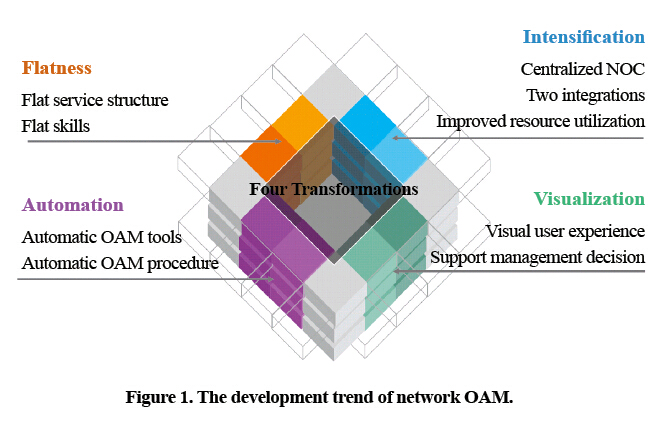Intensive OAM: Helping Operators Transform and Improve Efficiency
In the mobile internet era, telecom operators have made traffic operation their strategic goal for service development and profit growth. To support end-to-end services, operators need to gradually build and strengthen their infrastructure network and properly monitor and manage customer experience. They also need to reform the organization, objective and processes of network OAM. Operators have a clear aim for network OAM: create an integrated OAM evaluation system to facilitate the transformation from network-centric operation to operation focused on service quality and customer experience. Also, they seek to reform the existing OAM system and create an OAM model that combines centralized OAM and local OAM. This enables centralized monitoring at the provincial level. OAM transformation is inevitable for the sustainable development of telecom operators.
To keep up with the development of mobile internet and help operators transform themselves, ZTE has proposed next-generation operation. ZTE has years of experience in management services at home and abroad. In next-generation operation, traditional management services are integrated with ZTE's OAM support platform to create a flat, intensive, automatic, visual OAM system. This system improves efficiency and steers an operator towards intensification (Fig. 1).

Flatness
4G is now commercially available and as a result, networks have become larger and more complicated. Correlation and convergence of technologies and coordination between multiple parties have increased the requirements for network OAM in terms of capability and model. From a service perspective, the existing OAM model is challenged by diverse services, rapid deployment and application, and customer experience management. Operators are pressing to shift from voice-driven to traffic-centric operations and from the traditional multi-level group, provincial, municipal and county management structure to a flat service structure.
The increasingly flat, IP-based network architecture integrated with ICT technologies is also blurring the boundaries between industries. A unified intelligent delivery platform reduces the need for specialized skills of front-line maintenance personnel.
Intensification
Intensification is the most important way operators can reduce their TCO and greatly improve operational efficiency. Intensification involves:
● centralized network operations center (NOC). Increasingly intelligent BSS/OSS and extensive support methods have strengthened intensive network operations. Previously, monitoring centers were scattered in cities but are now centralized in an NOC. Most of the previous problems that had to be handled on site can now be addressed remotely in the NOC.
● two integrations. New OAM mechanisms based on integrated base stations and integrated equipment and lines are being developed step by step to improve OAM efficiency. Integration in base stations involves integrating maintenance and radio network optimization. Integration in other equipment and lines involves integrating the maintenance of transport devices and transmission lines.
● improved resource utilization. With the help of an E-Flow system, front-line OAM staff can receive and handle work orders in real time through their smart mobile terminals. These work orders can be marked, recorded, and traced end-to-end. Supported by the WFM personnel dispatching system, management staff can determine the workload of front-line OAM staff and adjust resources and tasks in a timely manner. In this way, the efficiency of front-line OAM staff can be maximized.
Automation
Automatic OAM tools greatly reduce the number of front-line OAM staff needed, makes OAM more efficient, and reduces opex. A full range of field-proven automatic OAM tools have been developed for the entire network OAM lifecycle. These are tools for network planning, deployment, configuration, commissioning, and maintenance.
As LTE arrives and self-organizing network (SON) technology matures, networks will be capable of automatically configuring, maintaining, optimizing, healing, and adapting themselves. At this stage, we can truly say that network OAM is intelligent.
Visualization
The ultimate goal of visualization is to make a network more controllable and manageable. Visualization involves visual network or service indicators, visual human resources or dispatching and tracing tasks, and visual managed services or evaluation. All this eventually helps improve OAM efficiency and quality.
Urban or local OAM subsystems always function as nerve endings of an operator’s entire OAM system. Information about the number of work orders, time in transit, time to visit sites, time to leave sites, fault handling, barcodes of spare parts, warehouse locations, and maintenance efficiency has always been invisible and unavailable to management personnel. Therefore, there is still plenty of room to improve management efficiency.
The visual mobile OAM solution is used for monitoring, managing, and tracing the whole process of OAM work orders handled by the urban or local OAM subsystems. Field OAM personnel can use mobile apps and terminals for mobility management, which includes GPS-based dispatching, and work order receiving, handling and closing. Apps can be used to trace and handle data in the process of work orders. Apps can also be used for recording and uploading information about time to mark, time to visit sites, and on-site photo shooting. All this provides a data basis for continually improving and optimizing field OAM efficiency.
Telecom operators are in a critical period of OAM transformation, and ZTE is looking forward to working with these operators to rapidly improve OAM efficiency and increase their market competitiveness.